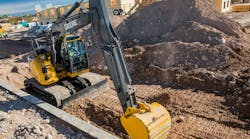When I first heard the name “Caterpillar Collaborative Solutions,” I was sure the group’s mission was getting Cat engines or chassis to other OEMs and finding a fit, working on things like integration for maximum performance.
I was about as accurate as “You can keep your insurance.”
In reality, this eight-year-old group inside Cat provides fleets with custom plans to increase productivity, cut costs, establish an equipment management strategy, and optimize the use of technology and capital.
Think consultancy, only for fleet management, and with more boots on the ground than suits in the suite.
“We focus on how fleets and people work together on a site, rather than the performance of the original machine,” says Craig Olmstead, Caterpillar division manager, Job Site Solutions. “And it’s not outsourcing,” Olmstead is quick to point out. “We’re taking the people who are already there and leveraging them.”
Specifically, the group applies Caterpillar resources as needed toward five areas:
- Equipment management, including maintenance and repair, and a strategy for optimizing life-cycle costs
- Production optimization, including fleet configuration and how the equipment works with the site itself (Olmstead: “Where are the bottlenecks? Is there something going on with operations that could be improved by deploying training resources?”)
- Safety
- Environmental sustainability, such as lowering the carbon footprint (Tier 5, anyone?)
- Financial design.
“No matter what metric a customer is using now, whether it’s EBITDA or operating expenses, we can put everything in dollars per hour,” Olmstead says. “We can help customers match expenses to revenues more efficiently.”
The group also addresses the little things that add up to productivity drains and operating cost increases, like unnecessary dips or poor configurations in a haul road.
“It could be a systematic change in operations, from improving safety to helping a fleet’s fuel burn to making sure the pass matches are correct,” Olmstead says. “It could also be overtime reduction, or getting more work done with fewer machines onsite.”
What Caterpillar Collaborative Solutions (CCS) would like to do is sign long-term alliance contracts with customers. “These are long-term fleet management partnerships,” Olmstead says.
And yes, Cat realizes you may have, and may continue to have, a mixed fleet.
At this point there’s been no press on CCS, and nothing looks to exist in writing outside Peoria. Case studies are being gathered from the aggregates industry, which has been its home until now. It’s all a bit nebulous, but it’s interesting. [UPDATE: Not so nebulous: Here's a web address with a downloadable brochure, made available a few days after this blog was published.]
Cat says it hasn’t had to do a lot of marketing so far. “We look to identify situations where this can work,” Olmstead says, “and we get requests through our Corporate Accounts team or dealers.”
Olmstead stresses the effort is not just for large fleets. “We find that large fleets look to us more for refinement, and we can offer mid-size fleets help with gaps in their operations and resources,” Olmstead says. “With small fleets, we can help because many don’t understand the technology available to them.”
The prime target for now is a fleet working on a process where machines stay in fixed locations, rather than on individual projects, but Olmstead said CCS could expand in that direction. So, while that sounds like all aggregates and mining all the time, Cat is also looking at construction contractors.
Anything that can help managers with operations and cost reduction deserves some consideration. We know all too well that asset managers need help with technology, particularly with telematics, and Cat Connect Solutions can be part of the CCS package.
But keep in mind there is a lot in play here: A head-spinning number of variables and the opportunity for tons of customization makes me wonder about the price of CCS involvement.
It depends on operational cost savings, according to Olmstead. “Customers have got to see five percent or more savings,” he says.
“We’re moving the pronoun from ‘I’ and ‘you’ to ‘we,’” sums up Mike Hinrichsen, Caterpillar’s manager, Quarry & Aggregates Industry & Corporate Accounts, for the Americas.
Though that might be one of the most saccharine pieces of sales speak I’ve heard lately (and maybe a candidate for one those “motivational” posters complete with a photo of stern-looking kittens), I get the impression there’s something big and worthwhile behind it.
We’ll keep you posted as Cat reveals more.





